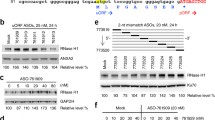Abstract:
Antisense sequences that hybridize to messenger RNA can inhibit target gene expression in a variety of ways. The best-known antisense mechanisms trigger messenger RNA (mRNA) degradation; however, translation repression by ribosome interference is a common natural antisense mechanism. In bacteria, there are fascinating examples of cis-encoded and trans-encoded antisense sequences that reversibly repress translation. In eukaryotes, microRNAs that bind 3′UTR target sequences also repress translation, although the mechanism is unclear. An important feature of translation repression is that the mRNA can remain intact during periods of repression, and rapid expression switching can occur in response to cellular and environmental signals. Recent genome analyses indicate many new short noncoding RNAs with predicted antisense activities. Therefore, translation repression by antisense sequences is likely to be a common and important form of posttranscriptional gene control, and such natural mechanisms provide a basis for the development of synthetic antisense gene control in research and drug development.
Similar content being viewed by others
Author information
Authors and Affiliations
Rights and permissions
About this article
Cite this article
Good, L. Translation repression by antisense sequences. CMLS, Cell. Mol. Life Sci. 60, 854–861 (2003). https://doi.org/10.1007/s00018-003-3045-4
Issue Date:
DOI: https://doi.org/10.1007/s00018-003-3045-4




